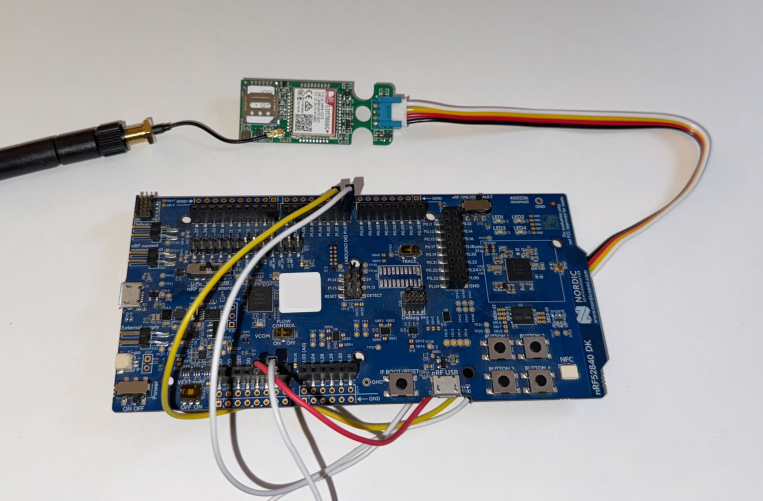In this post, we take a closer look at the SIMCom SIM7080G, a low-power cellular module that supports LTE-M and NB-IoT. It’s a solid choice if you’re using a separate microcontroller to run your application code since the SIM7080G handles only cellular connectivity. Unlike something like the nRF9160 SiP, which includes both a modem and an application processor, the SIM7080G is a modem-only solution. We’ll compare it to other common options like the BG95, explain how it fits into the Zephyr RTOS ecosystem, and walk through what it took to get it connected to Golioth.
What is the SIM7080G?
The SIM7080G is a cellular module from SIMCom that supports both LTE-M and NB-IoT. It is designed for low-power applications where cost and battery life are critical. The module communicates over a standard UART interface using AT commands, and it supports the functionality required by most connected IoT devices.
With an external modem like the SIM7080G, you choose the MCU — whether it’s ultra-low-power or more performance-oriented — depending on your needs. This closer your device looks to other options in our SDK (Zephyr, ESP-IDF, Modus Toolbox), the easier the implementation. In today’s article, we’ll lean on Zephyr and the modem subsystem for the firmware aspect and getting connected to the Golioth Cloud.
Making it work with Golioth
To test the SIM7080G, we used the M5Stack SIM7080G module connected to a Nordic nRF52840 DK over UART. The application was based on the Golioth Stream sample, which periodically sends data to the cloud.
Leveraging the Modem Subsystem
In Zephyr, we use the modem subsystem to manage this communication in a modular and maintainable way. It simplifies tasks like setting up a PPP connection, handling AT command sequences, and managing the network interface once connected.
The modem subsystem is built around familiar concepts from the Linux world:
- Chat: Automates AT command exchanges like dialing and connecting. This removes the need to write custom state machines or parsers for every modem.
- pppd: Manages PPP sessions, including authentication and IP negotiation. Once active, the PPP interface behaves like any other network interface in Zephyr.
- CMUX: Enables multiple data channels over a single UART. This allows simultaneous control (e.g., AT commands) and data transfer (e.g., PPP) without switching contexts.
Using this subsystem, we bring up the SIM7080G, establish a PPP link, and let Zephyr’s networking stack handle the rest. From there, the Golioth client connects like it would on any other interface.
Stream example changes
One of the key benefits of using Zephyr’s modem subsystem is that we didn’t need to modify any application code.
The only changes required were to the build configuration file in the nrf52840dk_nrf52840.conf file in the boards directory:
CONFIG_UART_ASYNC_API=y CONFIG_MODEM_CELLULAR_APN="your-apn" CONFIG_MODEM=y CONFIG_MODEM_CELLULAR=y CONFIG_MODEM_CELLULAR_UART_BUFFER_SIZES=4096 CONFIG_MODEM_CELLULAR_CMUX_MAX_FRAME_SIZE=4096 CONFIG_GOLIOTH_FIRMWARE_SDK=y CONFIG_GOLIOTH_SAMPLE_COMMON=y CONFIG_GOLIOTH_SAMPLE_HARDCODED_CREDENTIALS=y CONFIG_GOLIOTH_SAMPLE_PSK_ID="your-psk-id" CONFIG_GOLIOTH_SAMPLE_PSK="your-psk" CONFIG_GOLIOTH_STREAM=y CONFIG_GOLIOTH_DEBUG_LOG=y CONFIG_NET_L2_ETHERNET=n CONFIG_DNS_RESOLVER=y CONFIG_NET_L2_PPP_OPTION_DNS_USE=y CONFIG_GOLIOTH_SAMPLE_DHCP_BIND=n CONFIG_POSIX_API=y CONFIG_NET_PKT_RX_COUNT=10 CONFIG_NET_BUF_RX_COUNT=20 #Networking for cellular flags for cellular modem CONFIG_NET_DHCPV4=y CONFIG_NETWORKING=y CONFIG_NET_NATIVE=y CONFIG_NET_L2_PPP=y CONFIG_NET_IPV4=y CONFIG_NET_UDP=y CONFIG_NET_SOCKETS=y CONFIG_NET_CONTEXT_RCVTIMEO=n CONFIG_ZVFS_EVENTFD_MAX=22 CONFIG_ZVFS_OPEN_MAX=20 CONFIG_NET_SOCKETS_DTLS_MAX_FRAGMENT_LENGTH=2048 CONFIG_GOLIOTH_STREAM=y CONFIG_MBEDTLS_ENABLE_HEAP=y CONFIG_MBEDTLS_HEAP_SIZE=10240 CONFIG_NET_SOCKETS_DTLS_MAX_FRAGMENT_LENGTH=2048 CONFIG_MAIN_STACK_SIZE=4096 CONFIG_DNS_SERVER_IP_ADDRESSES=y CONFIG_DNS_SERVER1="1.1.1.1"
And in the nrf52840dk_nrf52840.overlay in the boards directory:
&uart1 {
compatible = "nordic,nrf-uarte";
current-speed = <115200>;
status = "okay";
modem: modem {
compatible = "simcom,sim7080";
status = "okay";
mdm-power-gpios = <&gpio1 3 GPIO_ACTIVE_HIGH>;
};
};
Because we’re relying on Zephyr’s driver architecture and network stack, the Golioth SDK works the same way as it does on platforms like the nRF9160. Once the PPP interface is up, the application sees a normal network interface and connects using standard BSD sockets.
This setup makes it easy to swap in the SIM7080G without touching your core logic. It’s a clean separation of concerns: your modem and connectivity are handled at the system level, while your application code stays focused on what it’s supposed to do — stream data to the cloud.
Future work on the SIM7080G
In this post, we used Zephyr’s generic cellular modem driver (CONFIG_MODEM_CELLULAR) to get the SIM7080G up and running with Golioth. This approach works well for basic connectivity and quick prototyping, but it doesn’t take advantage of modem-specific features or handle quirks unique to the SIM7080G.
In the next blog post, we’ll take things a step further by switching to a dedicated SIM7080G driver (CONFIG_MODEM_SIM7080). This will allow us to better manage power, improve connection stability, and lay the groundwork for a more production-ready integration.



No comments yet! Start the discussion at forum.golioth.io